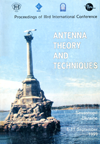Modern methods of analysis and computation of antenna radomes
DOI:
https://doi.org/10.1109/ICATT.1999.1236110Abstract
A radome, an acronym coined from radar dome, is a structure placed over an antenna that protects the antenna from its physical environment. Ideally, the radome is radio-frequency (RF) transparent and does not degrade the electrical performance of the en-closed antenna. Today, radomes find wide applications in ground, maritime, aircraft, and missile electronic systems (Fig. 1).
Very early methods of radome evaluation were cumbersome, relying on the use of a nomograph (1, 2). With the advent of the personal computer (PC), geo-metric optics approaches based on PC computers were developed (3, 4). But with recent advances in the PC speed and capabilities, physical optics based surface integration approaches that previously required a mainframe computer can now be accomplished on a PC (5).
References
Kaplun, V.A. Nomograms for Determining the Parameters of Plane dielectric Layers of Various Structure with Optimum Radio Characteristics. Radiotechnika I Electronika, 1965, Vol. 20, Part 2, No. 9.
Zamyatin, V.I.; et al. Antenna Fairings. V.I.Lenin Belorussian Publishing House, 1980 [in Russian].
Bagby, J. Desktop computer-aided Design of Aircraft Radomes. IEEE MIDCON ‘88 Conference Record, Western Periodicals Company, 1988.
Kaplun, V.A.; et al. Introduction to Computer Aided Design of Microwave Antenna Radomes. Radiotechnika i Electronika, 1987, Vol. 42, No. 2.
Kozakoff, D.J. Analysis of Radome Enclosed Antennas. Norwood MA: Artech House, 1987.
Milligan, T.A. Modern Antenna Design, New York: McGraw Hill Book Company, 1988.
Tricoles, G.; et al. Analysis of Radomes by the Method of Moments Method. Proc. of the 17th Symp. on Electromagnetic Windows, Atlanta, Georgia, 1984.
Wu, D.C.F.; Rudduck, R.C. Plane Wave Spectrum Surface Integration Technique for Radome Analysis. IEEE Trans. Antennas and Propagation, May 1974, Vol. AP-22, No. 3.
Joy, E.B.; Huddleston, G.K. Radome Effects on Ground Mapping Radar. Final Report on Contract DAAH01-72-C0598, MICOM, Huntsville, Alabama, May 1973.
Tavis, M. A Three-Dimensional Ray Tracing Method for Calculation of Radome Boresight Error and Antenna Pattern Distortion. TOR-0059 (56860), AD729811, Aerospace Corporation, May 1971.
Hayward, R.A.; et al. Accuracy of Two Methods for Numerical Analysis of Radome Electromagnetic Effects,” IEEE Int. Symp. Digest on Antennas and Propagation, Seattle, Washington, June 1979.
Raz, S.; et al. Numerical Analysis of Antenna Radome Systems. Proc. of the tenth III Convention in Israel, Tel Aviv, Oct. 1977.
Israel, M.I.; et al. A Reference Plane Method for Antenna Radome Analysis. Proc. of the fifteenth Symp. on Electromagnetic Windows, Atlanta, GA: Georgia Institute of Technology, 1980.
Joy, E.B.; et al. Comparison of Radome Electrical Analysis Techniques. Proc. of the Fifteenth Symp. on Electromagnetic Windows, Atlanta, GA: Georgia Institute of Technology, 1981.
Richmond, J.H. Scattering by Dielectric Cylinders of Arbitrary Cross Sectional Shapes. IEEE Trans. Antennas and Propagation, 1965, Vol. AP-13.
Richmond, J.H. The Calculation of Radome Diffraction Patterns. AD-423660, Department of Electrical Engineering, Ohio State University, 1966.
Richmond, J.H. TE Wave Scattering by a Dielectric Cylinder of Arbitrary Cross Sectional Shape. IEEE Trans. Antennas and Propagation, 1966, Vol. AP-14.
Tricoles, G.; et al. Wave Propagation Through Axially Symmetric Missile Radomes. AD-A106762 8, 1981.
Tricoles, G.; et al. Analysis of Radomes by the Method of Moment Method. Proc. of the Seventh Symp. on Electromagnetic Windows, Atlanta, GA: Georgia Institute of Technology, 1984.
Paris, D.T. Computer Aided Radome Analysis. IEEE Trans. Antennas and Propagation, 1970, Vol. AP-18.
Wu, D.C.F.; Rudduck, R.C. Plane Wave Spectrum Surface Integration Technique for Radome Analysis. IEEE Trans. Antennas and Propagation, 1974, Vol. AP-22, No. 3.
Joy, E.B.; Huddleston, G.K. Radome Effects on a Ground Mapping Radar. Final Report on Contract DAAH01-72-C-0598, MICOM, Huntsville, AL, 1973.
Burks, D.G.; et al. The Equivalent Source Concept Applied to the Analysis of Radome Performance. Proc. of Southeastcon 78, IEEE Region 3 Conf., Auburn University, Auburn, AL, 1978.
Bloom, D.A.; et al. Comparison of Spherical Wave Ray Tracing and Exact Boundary Value Solutions for Spherical Radomes. Proc. of the Seventeenth Symp. on Electromagnetic Windows, Atlanta, GA: Georgia Institute of Technology, 1984.
Kozakoff, D.J. Geometric Optics Radome Analysis Wall Solution Incorporating the Effects of Wall Curvature. Proc. of the SPIE OE/LASE 94 Int. Symp., Los Angeles, CA, 1994.
Kozakoff, D.J.; Hensel, J. Materials Implications of Millimeter Wave Radome Performance. Proc. of the IEEE Int. Conf. on Infrared and Millimeter Waves, Miami, FL, 1981.
White, D.J.; Banks, D.J. Plane Wave Transmission and Reflection Coefficients for Anisotropic Sheets of Radome Materials. Proc. of the Sixteenth Symp. on Electromagnetic Windows, Atlanta, GA: Georgia Institute of Technology, 1982.
Tricoles, G.; Rope, E.L. Scattering of Microwaves by Dielectric Slabs and Hollow Dielectric Wedges. J. Optics Society of America, 1988, Vol. 55, No. 11.
Ersoy, L.; Ford, D. RF Performance Degradation due to Random Radome Surface Irregularities. IEEE Antennas and Propagation Society Int. Symp. Digest, 86CH2325-9, 1986.
Vorobyev, E.A. Certain Production Criteria for Large Scale Monolithic Antenna Radomes. Izv. VUZ Radioteknika, 1966, Vol. 9, No. 3, p. 359-362, http://radio.kpi.ua/article/view/S002134701966030142.

